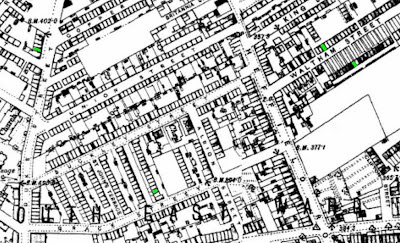I've been poorly over Christmas, a bad cold turned chesty by the Saturday before and a weekend's worth of incautious eating and drinking set off a flare up of Crohn's on Christmas Eve, no doubt exacerbated by the fight my immune system was already having to put up against the cold bugs. Since then I've not felt like blogging at all, or even turning on the laptop to do anything but watch DVDs, so waking up yesterday morning it was nice to feel that 'I must get on with something' feeling again.
 |
| News Flash on Ancestry Home screen |
The Ancestry front page had a flash advertising some new records, the West Yorkshire Electoral Rolls 1840 to 1962. I must admit that my first thought was 'oh dear' as Paul Stebbing, Chief Archivist at Barnsley Archives had recently told me that one of their new projects, thanks to a donation from the Friends of Barnsley Archives, was to be the scanning of the old pre-WW1 electoral rolls for Barnsley. I needn't have worried, however, as the set on Ancestry for Barnsley only covers the years 1887 to 1899.
The Third Reform Act of the 19th century, the Representation of the People Act 1884, had opened up the franchise to all men who paid an annual rent of £10 or who held land valued at £10 or more. This meant that many of our poorer ancestors now had the vote for the first time. Remember that no women could vote in Parliamentary elections, though some could vote in Parochial Elections and do appear in separate listings within these registers. Also around 40% of men still did not have the vote as they did not fulfill the property requirements.
 |
| A snip of the 1899 Barnsley Register of Electors showing women voters (from Ancestry) |
Opening the OH's family tree I went straight for one of his awkward ancestors, Edward Jones (yes, with a name like that it's not surprising he's awkward). I've never been able to successfully pin Edward down in the 1891 census and I hoped the electoral rolls would give me some pointers.
Entering Edward Jones in the search box I found that there were probably three gentleman by that name living in the Barnsley area in the period - skimming down the results screen I could see certain addresses repeating, Mapplewell, Royston and Smithies - not surprising as these were the areas where many Welsh miners settled after the opening of the Monckton colliery. Unfortunately it was impossible from the Electoral Rolls to work out which Edward Jones was the right one - as you only see the name of the man listed there is nothing to help differentiate one Edward Jones from another. I suspect my man was the one living at Wood Lane View, Carlton in 1895, but I have no way of proving this as yet.
Moving on to a more general search for the OH's ancestors in the Electoral Registers, this morning I looked for Robert Priestley, his 2x great grandfather. I know that Robert lived at 7 Park Row in 1881, 40 Waltham Street in 1891 and 9 Duke Street in 1901 from the census records, but given the propensity for people to move house according to the availability of money for rent, sizes and numbers of rooms needed for their family and so on, that didn't mean the family hadn't lived elsewhere as well.
 |
| 1888 Barnsley Register of Electors for the South East Ward (from Ancestry) |
I do know of one other Robert Priestley in Barnsley in the same era, a hairdresser who lived on New Street mainly (a shop?) so when two sets of results came up I wasn't surprised.
Eliminating the New Street ones I opened each of the others in turn and hit gold dust. These registers show when a voter moves from one house to another (I remember this from years ago searching through microfiche in Sheffield Local Studies Library, but hadn't come across it in Barnsley before). As you can see from the snip from the 1888 Register above the word 'successive' appears in the third or 'Nature of Qualification' column and two addresses are listed in the final column. This shows that Robert Priestley had moved from Duke Street to 28 Albion Terrace, Grace Street in the period of qualification for the 1888 Electoral Roll, presumably the previous year.
 |
| 1893 map of the Buckley Street area of Barnsley (from Old Maps) |
Albion Terrace was identified in the 1930 Register of Electors as being off Buckley Street, but as it runs through from Grace Street to Buckley Street this is not a big problem. By the 1960s both sides of the street appear on the maps as Wright Terrace, odds and evens, but in the 1930s Albion Terrace is the evens and Wright's Terrace only the odds so I am fairly confident that I've placed the green blob in the right place. Even the OH was getting interested by this time having realised that the blocks of flats that occupy the area now were named after the old streets. On Digimaps the jump from the 1960s map to the 1970s map is quite dramatic as the rows of narrow terraces were replaced by a few houses and the tower blocks.
In less than 10 years Robert Priestley and his family live at four different addresses in the same part of Barnsley. Robert was not a wealthy man, he was a Labourer for the Corporation in 1881, a Coal Miner in 1891 and a General Labourer in 1901. During this period his family grew from four to six children, which may account for some of his moves.
Using the Electoral Rolls, maps and other resources I have successfully plotted the moves of an ordinary family in Barnsley at the end of the 19th century.

No comments:
Post a Comment